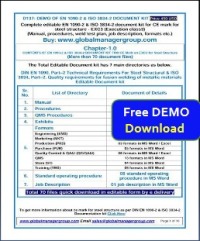Since 1st July 2014, CE Marking for Structural Steel becomes mandatory for steel working in accordance with EN 1090-2 in European Union (EU) and European Economic Area (EEA). CE Marking is regulated by criminal law and the penalties for not CE Marking or incorrect CE Marking, if found guilty, are a fine, imprisonment or both. The harmonised European standard that applies to structural steel is DIN EN 1090-2 and it will be an offence to supply structural steelwork
For all the organization of steel structural supply chain, it is essential that produce and understand the new requirements of CE Mark Structural Steel in order to ensure compliance. Non-compliance is clearly provided for in the regulations. However, the implications for the end user are also significant and not so obvious.
CE Marking requirements for structural steel
Factory Production Control (FPC)
The FPC is a system of documented procedures, flowcharts, assessment, inspection and test records, which are used to control and fully document the manufacturing process, ensuring consistency and full traceability. This is effectively the factory’s quality management system; it is similar to and shares a number of elements with the ISO 9001:2015 documents standard for Quality Management Systems.
Welding Quality Management System (WQMS) for CE Mark Certification for Structural Steel
For CE Mark Certification, a documented WQMS must be implemented and maintained in accordance with the relevant part of BS EN ISO 3834. Which part of BS EN ISO 3834 is relevant to the fabricator, will be determined by the Execution Class (EXC – see below) they are seeking to certify / CE Mark fabricated steel to.
Responsible Welding Coordinator (RWC)
Under the WQMS, fabricators working to Execution Class 2, 3 or 4 (EXC – see below), must appoint a responsible welding coordinator (RWC) with the competence and technical knowledge to control and supervise their EN 1090 welding activities. This is usually a competent person from within the fabricator or company, but may also be an outside provider or subcontractor. Competence is assessed on the basis of skills, knowledge and experience; these are demonstrated through evidence such as qualifications, certificates, log book and/or CV.
Those qualified to the following designations are automatically deemed to meet the competency requirements for an RWC:
- B – Basic: International Welding Engineer (IWE)
- S – Specific: International Welding Technologist (IWT)
- C – Comprehensive: International Welding Specialist (IWS)
Other routes to becoming a Responsible Welding Coordinator:
Evidence of an acceptable training course and competence, in line with the requirements of EN ISO 14731: Welding coordination – Tasks and responsibilities, and the relevant part of EN ISO 3834, Quality requirements for fusion welding of metallic materials. Practical experience in the relevant range of processes may also be acceptable.

